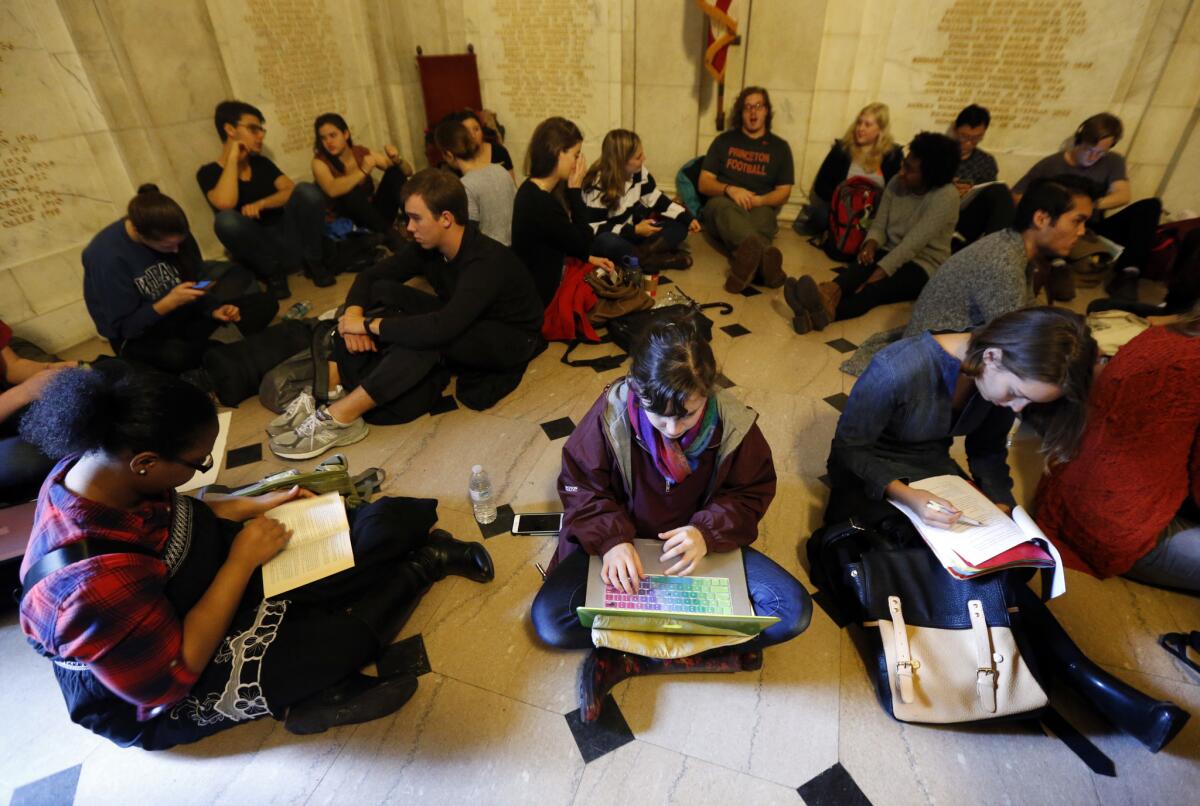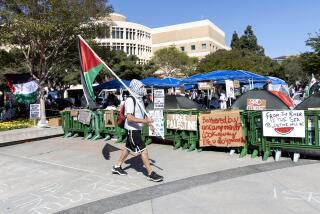Princeton agrees to examine Woodrow Wilson’s legacy on race after student protests

Students gather inside Nassau Hall during a sit-in on Thursday in Princeton, N.J. The protesters demand the school remove the name of former school president and U.S. President Woodrow Wilson from programs and buildings over what they said was his racist legacy.
- Share via
Reporting from New York — From fountains to sports teams, monuments to islands, the names that reflect this country’s troubled history have come under scrutiny from activists who want to replace them with labels that do not honor racists or promote ethnic stereotypes.
Rarely have presidential names come into the cross hairs, but on Friday, some Princeton University students were marking a victory of sorts after the Ivy League institution agreed to consider demands that it stop with the tributes to Woodrow Wilson, the 28th president of the United States.
Wilson was also a Princeton alumnus and the university president, and like many historical figures, he had views that might have been tolerated 100 years ago but that are considered unacceptable today. Chief among them was Wilson’s support of racial segregation, which was the law of the land when Wilson lived and remained so until the 1964 Civil Rights Act.
In a campaign against racism reminiscent of those seen at colleges across the country, a group of Princeton students staged a sit-in that ended Thursday night after protesters and university officials compromised on a number of demands. The demands included removal of a dining hall mural of Wilson, the renaming of buildings honoring him, and the setting aside of campus space for “cultural affinity centers.”
Dozens of students from the campus’ Black Justice League, a coalition of Princeton students, began the protest Wednesday outside of Nassau Hall, the 259-year-old building housing administrative offices at the New Jersey campus. Some of them eventually moved inside to occupy the office of the campus president, Christopher L. Eisgruber.
Hours of negotiations followed, finally ending when Eisgruber and 17 students signed off on a deal that appeared to leave breathing room for both sides, but was another example of student activists harnessing their numbers and their passion to effect change. Dean Jill Dolan and campus vice president for campus life Rochelle Calhoun also signed.
“We got out of them as much as we possibly could with the power constraints they had,” one of the student leaders, Wilglory Tanjong told the campus radio station, WPRB, after emerging from the president’s office to the applause of other students waiting in the adjacent atrium.
“We are happy, but we are not satisfied,” said Tanjong, adding that the group will “continue pushing.”
Here’s where the student protesters won: they got Eisgruber to promise to write to the Board of Trustees to begin talks on removing Wilson’s name from campus buildings. Eisgruber also agreed to ask the head of Princeton’s Wilson College to remove from its dining hall the mural depicting the former president.
In addition, the agreement mandates that four rooms on campus will be set up for cultural affinity groups. That presumably would meet the students’ demand for a campus space set aside specifically for black students but also would ensure other groups their own spaces.
Among other promises in the agreement: discussions on setting up campus housing for those interested in black culture, and enhancement of cultural competency training for staff. In addition, the agreement said the Board of Trustees would gather campus opinions on whether to change the name of Princeton’s prestigious Woodrow Wilson School of Public and International Affairs.
The protest comes on the heels of an uprising at the University of Missouri over racial issues, which led to the resignation this month of the school’s president and chancellor, and amid other campus unrest tied to student demands for greater racial and ethnic diversity and sensitivity.
The protests have been generally peaceful, but backlash has been ugly.
On Friday, police at Harvard were trying to determine who defaced portraits of several black professors at the Harvard Law School. The portraits were found Thursday with black tape covering their faces.
At the University of Missouri and Princeton, threats of violence were directed at protest leaders and black students.
The Harvard defacements followed protests by students demanding that the law school seal be changed because of its ties to the family crest of Isaac Royall Jr., an 18th-century slaveholder. Royall’s estate funded the first professorship at Harvard.
Ron Sullivan, one of the professors whose portrait had tape put over it, said he believed the vandalism was in response to the calls for the seal to be changed.
Protests have not been limited to college campuses. In July, the city of Buffalo, N.Y., changed the name of Squaw Island in the Niagara River to Unity Island after critics said the name was offensive to Native American women. There have been calls to rename a fountain in Washington, D.C., because it honors Francis G. Newlands, a former U.S. senator and founder of Chevy Chase, Md., who held racist views.
Countless petitions and protests have called for removal of monuments to Confederate heroes and renaming of sports teams, such as the Washington Redskins.
Sullivan, who is director of the Harvard Law School’s criminal justice institute, told Boston’s WGBH radio that the campus protests should be a wake-up call, because they speak to a nationwide feeling of isolation among blacks.
“The common theme is that African Americans all over the country are still feeling as though they are not an integral part of the larger community,” Sullivan said. “That you see students from … some of the most elite institutions in the world feeling this same thing should be a wake-up sign to the country that we really, really have to address this issue.”
ALSO
How the U.S. plans to stop the next Edward Snowden
Protests erupt after black man is shot by police in Minneapolis
Texas officials say Sandra Bland, who died in jail, was despondent over not making bail
More to Read
Sign up for Essential California
The most important California stories and recommendations in your inbox every morning.
You may occasionally receive promotional content from the Los Angeles Times.











